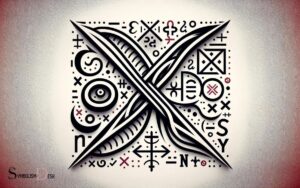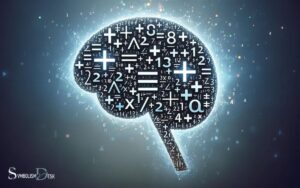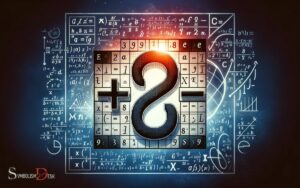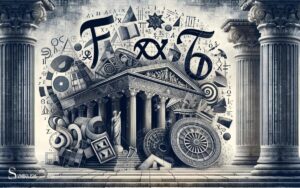Symbol for Union in Math: Explain!
The symbol for union in mathematics is “∪”. It denotes the joining together of two or more sets to form a new set that contains all the elements from the sets being united.
In set theory, a branch of mathematical logic, the union of two or more sets is the set that contains all the elements from the original sets, without duplication.
If you have two sets, A and B, their union is represented as A ∪ B. This new set includes all the elements from set A and all the elements from set B. If there are elements that appear in both sets, they are included only once in the union set.
Here’s an example with two sets:
- Set A: {1, 2, 3}
- Set B: {3, 4, 5}
The union of Set A and Set B, denoted as A ∪ B, is:
- A ∪ B: {1, 2, 3, 4, 5}
Note that even though the element “3” appears in both sets, it only appears once in the union. The union symbol “∪” is a fundamental component of set theory, illustrating the combination of distinct sets into a comprehensive whole.

Key Takeaway
Definition of Union Symbol
The union symbol in mathematics, denoted by the symbol ‘∪’, represents the combination of sets, including all elements that are in at least one of the sets.
When two or more sets are joined together using the union symbol, the resulting set contains all the distinct elements present in any of the original sets.
For example, if set A = {1, 2, 3} and set B = {3, 4, 5}, then A ∪ B = {1, 2, 3, 4, 5}. The union operation is fundamental in set theory and various branches of mathematics, including algebra and probability.
Understanding how to use the union symbol is crucial for solving mathematical problems involving the combination of different sets.
Notation and Representation
Notation and representation of the union symbol in mathematics are crucial for accurately expressing the combination of sets. Notation and representation of the union symbol in mathematics are crucial for accurately expressing the combination of sets. The union of two sets is typically denoted by the symbol ‘∪’, which signifies the inclusion of all unique elements from both sets. This is distinct from symbols like ‘||’, which represent two vertical lines in math, often used in contexts such as absolute value or parallel lines. Understanding these symbols ensures clarity and precision in mathematical expressions.
The symbol for union, denoted by ∪, represents the joining of two or more sets to form a new set that contains all the elements of the original sets. In set notation, the union of sets A and B is written as A ∪ B.
This notation is essential for clearly conveying the concept of combining sets in mathematical expressions and equations.
Additionally, Venn diagrams are often used to visually represent the union of sets, with overlapping circles showing the elements that belong to either or both sets.
Understanding the notation and representation of the union symbol is fundamental for effectively working with sets and solving mathematical problems.
Properties and Operations
In the study of properties and operations related to the union symbol in mathematics, several key points come to the forefront.
These include the commutative property of union, the distribution of union over intersection, and the associative property of union. Understanding these properties and operations is essential for effectively manipulating and analyzing sets in mathematical contexts.
Commutative Property of Union
The commutative property of union states that when combining sets A and B with the union operator, the result is the same regardless of the order in which the sets are combined.
- Key Point 1: Understanding this property is crucial in set theory and various branches of mathematics.
- It allows for flexibility in manipulating and simplifying expressions involving unions of sets.
- Knowing that the order of set combination does not affect the result simplifies calculations and problem-solving processes.
This property is fundamental in mathematics, especially in set theory and algebraic structures. It ensures that the outcome of combining sets through union remains consistent, regardless of the order in which the sets are united, thereby simplifying mathematical operations and reasoning.
Union Distributes Over Intersection
Union distributes over intersection in mathematics, allowing for specific operations and properties within set theory and other mathematical areas.
This distribution property is formally known as the distributive law of sets and is represented as A ∪ (B ∩ C) = (A ∪ B) ∩ (A ∪ C).
The table below illustrates the distribution of union over intersection using sets A, B, and C.
| Operation | Representation |
|---|---|
| Union over intersection | A ∪ (B ∩ C) |
| Left-hand side of the distribution | A ∪ (B ∩ C) |
| Right-hand side of the distribution | (A ∪ B) ∩ (A ∪ C) |
Understanding the distribution of union over intersection is crucial for various mathematical applications, including probability theory, logic, and database queries. It provides a fundamental framework for organizing and analyzing data in diverse fields.
Associative Property of Union
An essential aspect of set theory in mathematics, the associative property of union establishes the conditions under which the grouping of sets in a union operation does not affect the final result. This property is crucial in understanding how unions of multiple sets are evaluated.
Consider the following points:
- Definition: The associative property states that for any three sets A, B, and C, (A ∪ B) ∪ C = A ∪ (B ∪ C).
- This means that the result of a union operation among three or more sets remains the same regardless of how the sets are grouped.
- Practical Significance: Understanding the associative property is fundamental for simplifying complex union operations and for proving various theorems in set theory.
Union in Set Theory
In set theory, the operation of combining two or more sets to form a new set is denoted using the symbol for union, which is represented by the symbol “∪”. The union of sets A and B, denoted as A ∪ B, is the set that contains all elements of A and B, without repetition.
For example, if A = {1, 2, 3} and B = {3, 4, 5}, then A ∪ B = {1, 2, 3, 4, 5}. The union of sets can also be extended to more than two sets.
The union of three sets A, B, and C, denoted as A ∪ B ∪ C, is the set containing all elements that are in A, B, or C. Understanding the concept of union in set theory is essential for various applications in algebra.
Applications in Algebra
In the realm of algebra, the concept of union plays a crucial role in solving equations involving multiple sets. Understanding how to work with unions of sets is essential for tackling algebraic problems that involve overlapping or combined elements.
This application of the union symbol in algebra has significant implications for solving equations and manipulating mathematical expressions.
Solving Equations With Unions
The application of solving equations with unions in algebra provides a method to address complex mathematical problems involving multiple sets of variables and conditions.
This technique is particularly useful when dealing with overlapping or intersecting sets, allowing for the simultaneous consideration of different scenarios.
Key points to consider include:
- Flexibility: Equations with unions offer the flexibility to account for various conditions and variables concurrently, streamlining the problem-solving process.
- Real-world Applications: This method is applicable in real-world scenarios where multiple factors influence an outcome, such as in economics, engineering, and statistics.
Union of Sets
A significant aspect of algebra involves understanding the applications of the union of sets, which plays a crucial role in solving mathematical problems involving multiple sets and their relations.
The union of sets, denoted by the symbol ∪, combines all the elements of the sets involved without duplicating any element.
In algebra, this concept finds various applications, especially in solving equations and inequalities involving multiple sets.
Understanding the union of sets is essential for grasping fundamental algebraic concepts and for solving problems in real-world scenarios.
Below is a table illustrating the union of sets:
| Sets A | Sets B | A ∪ B |
|---|---|---|
| 1, 2, 3 | 3, 4, 5 | 1, 2, 3, 4, 5 |
| a, b | b, c, d | a, b, c, d |
| x, y, z | y, z, w | x, y, z, w |
This table demonstrates how the union operation combines the elements of two sets.
Algebraic Implications
Algebraic applications of the union of sets play a pivotal role in solving mathematical problems involving multiple sets and their relations. Understanding the algebraic implications of set unions is essential for various applications in algebra.
Here are key points to consider:
- Intersection with Complements: The union of sets can be used to express the complement of the intersection of sets, a concept crucial in solving equations and inequalities.
- Example: In solving simultaneous equations, the union of sets helps in expressing the solution space efficiently.
- Algebraic Expressions: Union of sets is utilized in forming algebraic expressions and equations, allowing for the representation of complex relationships between sets.
- Example: In polynomial equations, the union of solution sets aids in finding the complete solution space.
Understanding these applications is fundamental for mastering algebraic problem-solving techniques.
Conclusion and Further Learning
Conclusively, understanding the symbolism and applications of union sets is a fundamental skill for proficient mathematical reasoning and problem-solving.
The concept of union in mathematics is not only valuable for algebraic manipulations but also for various real-world applications.
It forms the basis for solving complex problems in fields such as statistics, computer science, and engineering. Further learning in this area can involve exploring more advanced topics like intersection, complement, and the use of Venn diagrams to visualize set relationships.
Additionally, understanding the role of unions in probability theory and logic circuits can provide a deeper insight into the practical significance of this concept.
By mastering the concept of union sets, individuals can enhance their analytical skills and better comprehend the interconnectedness of different mathematical principles.
Conclusion
The union symbol in math serves as a bridge that connects different sets, allowing them to come together and form a unified whole.
Just as a conductor leads a symphony, the union symbol orchestrates the harmonious blending of mathematical elements.
By understanding its notation, properties, and applications, one can unlock the power of the union symbol in various mathematical contexts.
Further exploration and mastery of this concept will open doors to deeper mathematical understanding and problem-solving skills.






